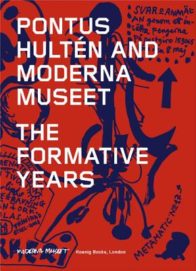 Edited by Anna Tellgren
Edited by Anna Tellgren
Foreword by Daniel Birnbaum
Text by Patrik Andersson,
Annika Gunnarsson, Ylva Hillström,
and Pontus Hultén
Koenig Books ($30)
by Richard Kostelanetz
Of the many impresarios of contemporary visual art, Pontus Hultén (1924-2006) ranked for a while among the more prodigious. He moved from institution to institution, from country to country, always as a chief who apparently understood early that he’d better speak several languages fluently and own a big suitcase. As director of Moderna Museet in his native Stockholm from 1958 to 1973, he built an international reputation with such exhibitions as Nikki de Saint Phalle (1960), Movement in Art (1961), American Pop Art (1964), Claes Oldenburg (1966), and Andy Warhol (1968). Every two years at least, one exhibition was devoted to new American art, which Hultén helped make more acceptable in Europe. At the Museum of Modern Art in New York, he also guest-curated The Machine as Seen at the End of the Mechanical Age (1968).
Hultén then became, in 1973, the founding director of the Centre Georges Pompidou in Paris. There he mounted mammoth exhibitions with Paris in their title, associating the city with Moscow and New York. By 1980 he was in Los Angeles establishing its Museum of Contemporary Art. Less successful in California, he went in 1984 to Venice, Italy, taking charge of the Palazzo Grassi. In 1985 he joined others in founding an art college in Paris. From 1991 to 1995 he directed a museum in Bonn, Germany, and later the Jean Tinguely Museum in Basel, Switzerland. Just before his death, Hultén gave his private collection of several hundred art objects, many no doubt acquired as gifts directly from artists, to his original launching pad, Stockholm’s Moderna Museet, with the stipulation that they be exhibited not within the museum itself but in a separate warehouse.
Ponthus Hultén and Moderna Museet: The Formative Years is a collection of scholarly appreciations, all in English sometimes askew, ostensibly about the first phase of his museum career. This footnoted collection smells like the transcripts of some institutional conference, though none is acknowledged. In the preface is this crucial sentence: “One of his greatest gifts was his sense of timing, his ability to be at the right place at the right moment and to home [sic] in on the most interesting things going on.”
While this quality is evident in his Swedish career (and perhaps in his Parisian one as well), Hultén evidently lost his touch once he went to California. After Hultén quit Los Angeles and returned to Europe, he was curatorially broken, so to speak. Perhaps the hidden truth of Hultén’s meteoric career is that California, especially LA, irrevocably alters American easterners and Europeans—and rarely for the better.
